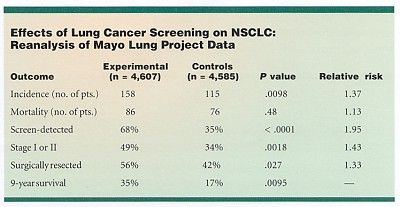Reanalysis Suggests Mortality Advantage for Lung Cancer Screening Screening
SAN FRANCISCO-The Mayo Lung Project has been widely interpreted to be negative because it failed to demonstrate a significant reduction in lung cancer mortality among persons randomized to screening chest x-rays. But a rigorous new analysis, with mortality adjusted for cancer incidence, suggests otherwise: that mortality from non-small-cell lung cancer (NSCLC) is reduced by chest x-ray screening and that public policy recommendations against screening deserve to be reconsidered.
SAN FRANCISCOThe Mayo Lung Project has been widely interpreted to be negative because it failed to demonstrate a significant reduction in lung cancer mortality among persons randomized to screening chest x-rays. But a rigorous new analysis, with mortality adjusted for cancer incidence, suggests otherwise: that mortality from non-small-cell lung cancer (NSCLC) is reduced by chest x-ray screening and that public policy recommendations against screening deserve to be reconsidered.
Gary Strauss, MD, MPH, of the Roger Williams Cancer Center, Providence, Rhode Island, presented the findings at the 37th Annual Meeting of the American Society of Clinical Oncology (ASCO).
The controversy over chest x-ray screening is primarily based on the uncritical acceptance of mortality as the primary endpoint, said Dr. Strauss, a physician and epidemiologist. The Mayo study did show an advantage for screening based on survival and other clinical endpoints, he noted.
However, he said, no endpoint invariably provides an unbiased measure of screening effectiveness. "Mortality can be biased, when randomization fails to accomplish what it is assumed to accomplish. And survival can be unbiased when confounding influences of conventional screening biases are eliminated," he said.
He defined "survival" as an outcome measure in a population with a disease. "Mortality," on the other hand, is related to the risk of disease in an entire population, he explained.
The question is, he said, "What is the best endpoint that allows us to measure the value of screening?" It has been assumed to be mortality, but Dr. Strauss explained that problems with the mortality endpoint have been under-recognized.
The Mayo Lung Project involved 10,933 male smokers age 45 and over who were randomized into two groups. The experimental group underwent chest x-ray and sputum cytology every 4 months for 6 years, followed by 3 years of observation. The control group had no regular screening per protocol but received recommendations for annual chest x-ray and sputum cytology, and then were followed for 9 years.
During the 9 years of the study, 366 lung cancers were detected. Because early detection is unlikely to have a survival benefit in small-cell lung cancer, only cases of NSCLC (273 cases) were considered in Dr. Strauss’ analysis.
The method of detection was chest x-ray in 129 cases (47%), sputum cytology in 18 cases (7%), and clinical symptoms in 126 cases (46%).
Kaplan-Meier estimates, in which survival is measured from randomization and which includes both screen-detected and symptom-detected cases, demonstrated a significant survival advantage favoring the experimental group (see Table).

Dr. Strauss noted that a mortality disadvantage is possible in the experimental group, despite more favorable stage and survival benefits, because NSCLC incidence was 37% higher in this group.
By multivariate analysis, the only significant predictor of NSCLC mortality was presence of surgically resected disease, with a hazard ratio of 0.27. When adjusted for differences in resectability, neither screen-detection nor intervention group (experimental vs control) was significant. When adjusted for differences in incidence, however, the experimental group had a significant reduction in NSCLC mortality (hazard ratio 0.70), he reported.
The objective of screening is to identify resectable early-stage NSCLC, Dr. Strauss said. Among 136 resected patients (88 in the experimental arm and 48 in the control group), 9-year survival was 53%, while among 137 unresected patients (70 in the experimental group and 67 in the control group), 6-year survival was 0% (P < .0001).
"The implications of population-based annual screening of persons at high risk for lung cancer in the United States is that many tens of thousands of lung cancer deaths could be avoided," he remarked.
Moreover, Dr. Strauss pointed out that current radiologic screening is more effective than the screening that was done during the Mayo Lung Project in the 1970s and 1980s. "Chest x-rays are better now, although they will not pick up every lung cancer. If I were in charge of public policy, I would recommend screening persons with a significant smoking historysay, 20 or 30 pack years," he said.